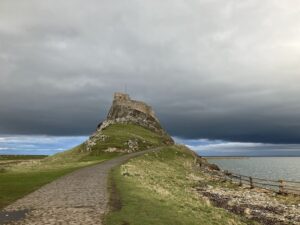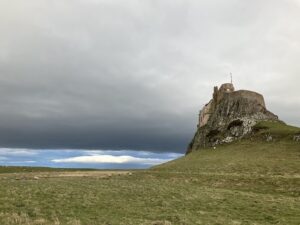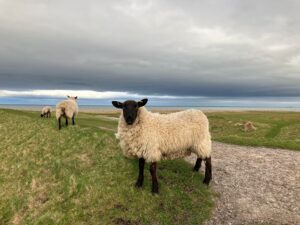8. A Spring in Britain: Lindisfarne
Lindisfarne, more often referred to as Holy Island, is a half hour’s drive from Berwick, just down the main coast road. You might think it’s easy to get to. It’s not. Without a car, the choice is an $80 taxi or the bus, which leaves Berwick on Wednesday mornings. The only bus off the island is on Saturday mornings. I decided that if I wanted to have an experience worth all the trouble of getting to Holy Island, I would have to spend a few days there so I got an Airbnb from Wednesday to Saturday.
The island is cut off from the mainland twice a day by the tide as every fan of Vera knows. She is shown zooming over the connecting causeway, rooster tails on both sides, as she crosses just before the water covers the road. The bus schedule doesn’t allow for anything that dramatic. It crosses well before water covers the road. Being at the mercy of the tides, the schedule changes every day of the year. The best way to make sure you get to Holy Island is to figure out the bus schedule at home before you even leave the U.S., have it confirmed by the owner of the Airbnb on Holy Island as well as the host of the Airbnb where you are staying in Berwick, check with the station in Berwick, ask Graham, the bus driver you met your first day in Berwick and get it confirmed by the driver before you ever set foot on the bus itself. Then you can be reasonably certain you will at least get there. Must do everything in reverse to get yourself off the island. But I’ll get to that.
The other quirky thing I encountered in my plans to go to Holy Island involved paying for the Airbnb. My hostess said that she often had trouble processing American credit cards so she waived the deposit when I booked the room and told me to just bring cash when I came. When I got to the island, I was to give the cash to Debbie who worked in the village post office and who serviced the Airbnb rooms (which was unimaginatively called “holyislandaccommodations.com.”) Should I repeat all that? It seemed unreal; on the other hand, British money is so pretty, it hardly seems real.
I arrived on Holy Island at 9:45 Wednesday morning with 400 GBP in cash hidden obsessively in my travel vest. Debbie, at the post office, told me to just leave the money in the room when I left on Saturday and she would get it when she cleaned.
I still felt unwell, it was cold and raining and my room wouldn’t be ready until 1:30. I left my luggage in the village shop, wandered the streets and had a cup of tea in each of the three cafes and one of the pubs until I was finally able to collapse on the bed in a room that was sweltering from the heat coming off the towel rail in the bathroom. In the evening, I did a bunch of hand laundry, which dried before I fell asleep.
My first full day on Holy Island began with my porridge overflowing in the microwave. The mess it made looked a bit like I felt but eventually I got myself out into a day that was warm. When my hands and feet were freezing on Mull, Wendy and I had had this conversation:
“Do you think it will be cold on Holy– ?”
“Yes.”
“Do you think it will be colder than her–?”
“Yes.”
The warmth on Holy Island was both welcome and unexpected.
Lindisfarne Castle was on Thursday’s itinerary. It’s an imposing, moody looking structure that sits out in the North Sea and can be seem from Berwick on a clear day. And incidentally, opening and closing times of all the shops, cafes and attractions vary, like the bus, with the tides and are usually pushed up about half an hour every morning. On the half mile walk to the castle, I joined the day tourists who had arrived when the causeway opened, some dressed like pilgrims and druids.
The inside of the castle was a bit disappointing. The structure itself is 16th century but it had been bought and remodeled in the Arts and Craft style in the early 1900s by a Sir Edward Lutyens. When it was taken over by the National Trust in 1944, they buffed up the remodel rather than restore it to its 16th century look.
However, the actual setting cannot be equaled and that was never so apparent until the afternoon when tourists left, everything closed and the 150 residents all went to their own homes on the island. In the evening when I walked back to the castle, everything was moody and ethereal and it was pretty much just me, the sheep and the nun Kyra with her little dog Tessa.

The next morning, Friday, when I got out of bed, I could barely walk. I was dizzy and felt nauseous. I sat back down and thought, “This feels weird. These are not “normal” symptoms. I feel drugged.”
The only drug I had been taking aside from a few prescriptions, which shall go nameless–I know I disclose a lot about myself but even I have limits– was the Night Nurse medication that Wendy and Sue had gotten for me while we were on Mull. I had finished the five doses in that box and had bought another at the Boots in Durham. Now, sitting on the bed in my airbnb on Lindisfarne, I read the label. “Do not exceed four doses.” I had taken seven. “Oh my god,” I thought. “I’ve poisoned myself.”
Andrew asked, “What’s in it?”
“I don’t know. Probably paracetamol and there’s Dex-something.”
“Dextromethorphan Hydrobromide?”
“How do you know something like that?”
“Because I look at what I put in me.”
Sue said, “Probably a good idea to read the directions.”
I thought, “I shouldn’t have been let out of my house.”
I had a slow morning. I drank a lot of water and didn’t take any pills of any kind all day. Late in the morning I ventured out to walk carefully around the Lindisfarne Priory. The medieval priory was built on the site of an even earlier Anglo-Saxon monastery. The Lindisfarne gospels were created there. St Cuthbert whom we met in Durham holding the head of St Oswald, lived and worked there until he’d had enough and retired down the beach to live as a hermit. He was originally buried on Lindisfarne but his body, which in eleven years had not decayed a bit thus insuring his sainthood, was moved to Durham when the Vikings raided the island in the 800s.



 RSS Feed
RSS Feed





Traveling while unwell is the pits, not to mention you had poisoned yourself, Elena!
I love the first picture with the clouds above the castle and also the handsome, black-legged sheep that scurried away from their video predator.